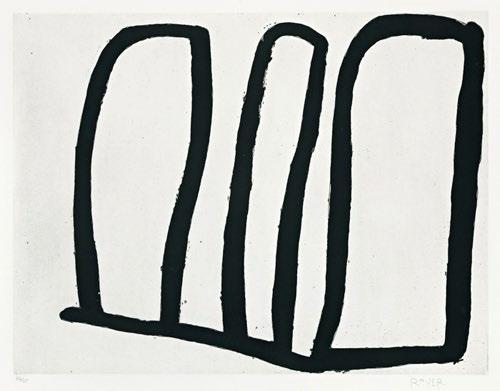SECONDARY MARKET SYDNEY CONTEMPORARY
EMILY KAME KNGWARREYE (EMILY KAM KNGWARRAY)
(1910 - 1996)
ALALGURACOUNTRY,1993
91 x 120.5 cm; 122.5 x 92.5 cm (framed)
acrylic on linen
$185,000
PROVENANCE
Painted at Delmore Downs in January 1993
Delmore Gallery, Delmore Downs NT Cat. No. 93A76
The Thomas Vroom Collection, The Netherlands Ebes Collection, Naarm (Melbourne), Vic Private collection, Gadigal (Sydney), NSW
EXHIBITED
Schittering/Brilliance, AAMU - Museum for Contemporary Aboriginal Art, Utrecht, The Netherlands, 12 October 2007 - 23 March 2008
The Anooralya Yam plant is Emily Kngwarreye’s main totem and story and has characteristics that make it an important food staple in the arid lands north-east of Alice Springs. Its ability to keep relatively fresh after picking, and to keep well underground is highly valued. The yam flower and the seeds it contains are a preferred food of the Emu. These can be processed into a seed cake . As for the yam, ‘it always comes back’ - a very telling statement in the harsh desert environment. Emily’s double-dipped brushwork celebrates the presence of food underground.
This is a fine example of Emily painting in anticipation of the completion of ceremonies being held in her country Alalgura during the summer of 1993. Many of her greatest paintings were created during the ceremonial season as women dance to ensure that there will be abundance during the year ahead.
Emily Kame Kngwarreye is widely regarded as Australia’s most important and successful Aboriginal artist. Her remarkable career lasted just 7 years until her passing at 86 years of age in 1996. The painterly quality and originality of her works extended her influence far beyond the reach of Aboriginal art, attracting an international audience ready to acclaim her new and innovative style which remains as popular today as they did almost 25 years ago.

EMILY KAME KNGWARREYE (EMILY KAM KNGWARRAY)
(1910 - 1996)
SUMMERABUNDANCEV,1993
90 x 120 cm; 92 x 122 cm (framed)
acrylic on linen
$185,000
PROVENANCE
Painted at Delmore Downs in December 1993
Delmore Gallery, Delmore Downs NT Cat. No. 93L050
The Thomas Vroom Collection, The Netherlands Bonhams, Aboriginal Art: The Thomas Vroom Collection, Sydney, NSW, September 2015, Lot No. 207
Private collection, Naarm (Melbourne), Vic
Accompanied by a certificate of authenticity from Delmore Gallery
Bears inscription verso: commissioned by Delmore Gallery via Alice Springs NT, 93L050, Emily Kngwarreye
In this work, painted in December 1993, the application of yellow and green highlights the varied and changing hues in the life cycle of the Anooralya Yam and other food plants found near Alalgura on Utopia Station, west of Delmore Downs. Viewed from an aerial perspective, the painting reveals the sporadic, clustered growth that emerges following summer rain. The flourish of new life that follows is both exceptional and rapid.
While Emily Kame Kngwarreye was preoccupied with the life cycle of the yam and the women’s ceremonies that celebrate its importance, she explored many interrelated themes-using these subjects to express her Country as a whole. The Anooralya Yam is her principal totem and story. It is a plant of great cultural and practical significance in the arid lands north-east of Alice Springs, valued for its ability to stay fresh after harvest and store well underground.
The yam flower produces seeds (“kame”) that can be processed into a seed cake, and the flower itself is a favoured food of the emu. The resilience of the yam -“it always comes back”- is a powerful metaphor for survival in the desert environment.
Kngwarreye’s use of yellow signals the strong presence of the kame daisy. Her energetic double-dipping brushwork evokes the richness of food hidden underground. Ceremony ensures that good seasons return, and Emily believed that her ritual role helped bring this about-that she “grew up” the food and the people of her Country.
This work is a fine example of Emily painting in anticipation of ceremonies being completed on her Country at Alalgura during the summer of 1993.

EMILY KAME KNGWARREYE (EMILY KAM KNGWARRAY)
(1910 - 1996)
ANKARAMERNE-INTEKWE,1990
122 x 92 cm; 126 x 96 cm (framed)
acrylic on linen
POA
PROVENANCE
Painted in Utopia, March 1990
CAAMA Shop (Central Australian Aboriginal Media Association), Alice Springs, NT Cat No. 21-390
Utopia Art, Sydney NSW
Private collection, Vic
Accompanied by the signed original certificate of authenticity from CAAMA Shop
bears inscription verso: EMILY KNGWARREYE; 21390
EXHIBITED
FirstSoloExhibition,Utopia Art Sydney, NSW, April 1990
Emily Kngwarreye’s FirstSoloShow was held at Utopia Art Sydney in April 1990. Not surprisingly it attracted attention from contemporary collectors from across the country, a few curators and a lot of artists, many of whom still express their deep regret at an opportunity missed!
Utopia Art Sydney in those days was at Stanmore at the top of two flights of stairs, and this painting was the first to come into view as you entered the gallery. Ankara Merne - Intekwe was catalogue number 6 in an exhibition of 19 paintings. It was snapped up on the opening day and its been in the same hands ever since.
Rodney Gooch, Emily Kngwarreye and I had discussed the concept of a solo exhibition the previous year, and Kngwarreye began work on the show soon after but this was one of the last works to be finished for the show, painted in March 1990. It is an outstanding example from this period.
Layer upon layer of fine dotting subtly reveals the underlying structure below. Earthy pinks and ochres form undulating, shifting fields. Touches of red and yellow ochre, and highlights of black
and white, meld together to form a rich deep space that draws you in. You can see the very Kngwarreye touch of a few extra dots here and there that add spark and mystery to the composition. You can feel the artist working through the layers, energising the field with every mark.
The sides of the canvas are painted too, with the stripes which we know represent body paint or ‘awelye’. They border the composition and though not visible when looking head on, they nevertheless add to the real presence this painting exudes. These borders were a special element that was soon to disappear, until the major breakthrough paintings of 1994 when the ‘awelye’ took centre stage.
Today this painting is an absolute classic of its era, fine dotting with endless variation. Offered for the first time since it was collected 35 years ago, perfect provenance, from her First Solo Show.
It’s a joy to see it again. Don’t miss the opportunity this time!
Christopher Hodges April, 2025
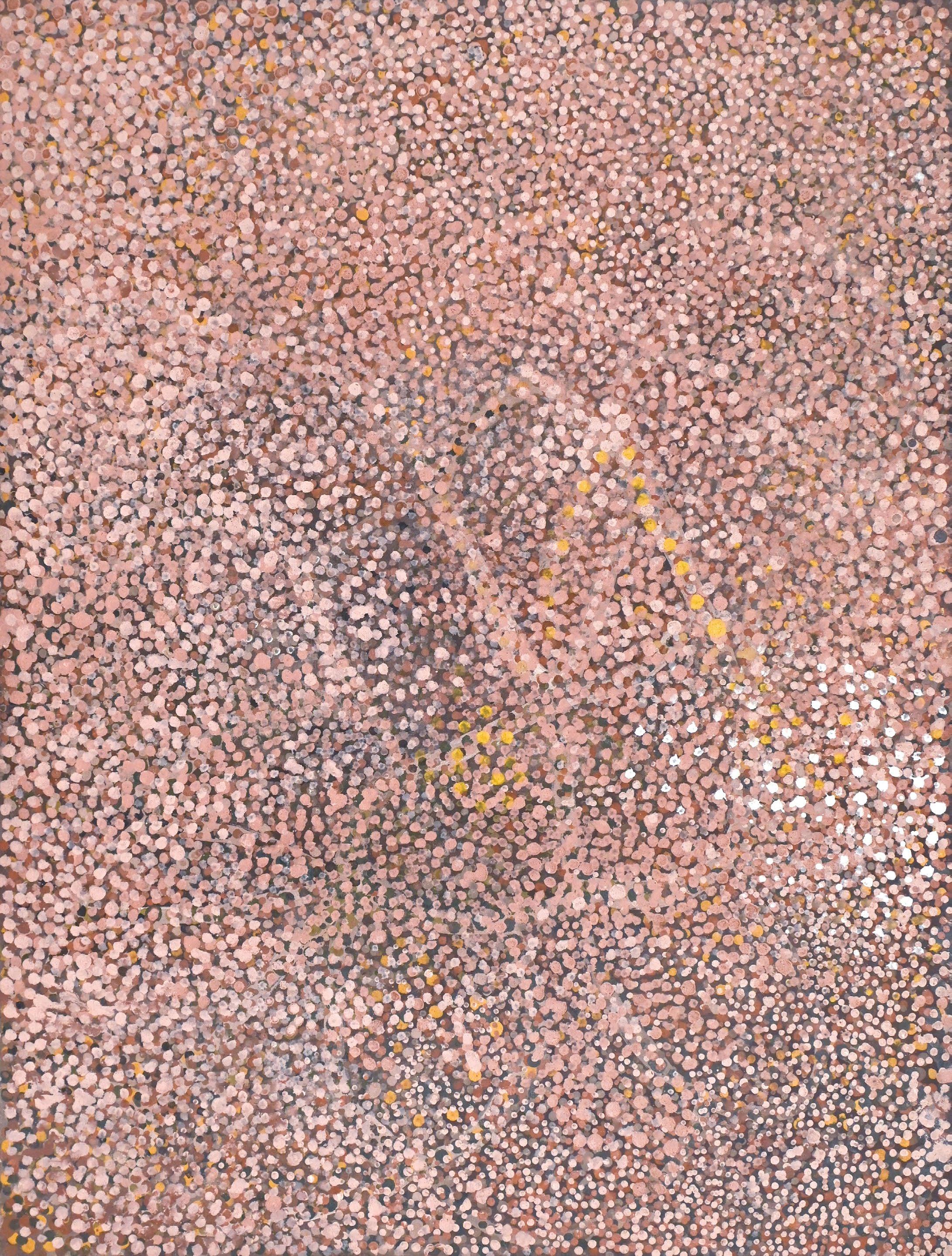
EMILY KAME KNGWARREYE (EMILY KAM KNGWARRAY)
(1910 - 1996)
ALALGURA(MYCOUNTRY),1994
151.5 x 91 cm
acrylic on linen
$300,000
PROVENANCE
Delmore Gallery, NT Cat No. 94J006
Private collection, NSW
Signed ‘emily’ verso and bears inscription: ‘94J006, Emily Kngwarreye, commissioned by Delmore Gallery, via Alice Springs, NT’
Emily Kame Kngwarreye is widely regarded as Australia’s most important and successful female artist. Her remarkable career lasted just seven years prior to her death at 86 years of age in 1996. The painterly quality and originality of her works extended her influence beyond the reach of Indigenous art and attracted an international audience ready to acclaim her new and innovative contemporary style.
In this highly dramatic work, colours highlight the varied and changing hues in the life cycle of her country after seasonal change that brings rain to the the dry desert landscape near Alalgura on Utopia Station, west of Delmore Downs.
The thick textured fusion of deep blue, green and pink hues gives a concentrated view of the desert’s food sources after rain. Often hidden from view, these seed, fruit, and root vegetables are enormously bountiful. The requirement to understand the
life cycles of all bush foods is necessary to the survival of Alyawerre and Anmatjerre people.
The Anooralya Yam is the most important plant in Emily’s custodianship. This hardy and fertile plant provides both a tuber vegetable and a seed bearing flower called Kame (Emily’s tribal name). As the plant dies off above the ground, the yam tuber can be found underground.
This work evokes the flourish of growth that is exceptional and rapid. The dramatic transformation of the desert from bare to abundant is a display of the desert’s power. Linked into this is women’s ceremonial life called ‘awelye’ that is based on the belief that they help nurture the desert food sources by assuring future fertile generations.
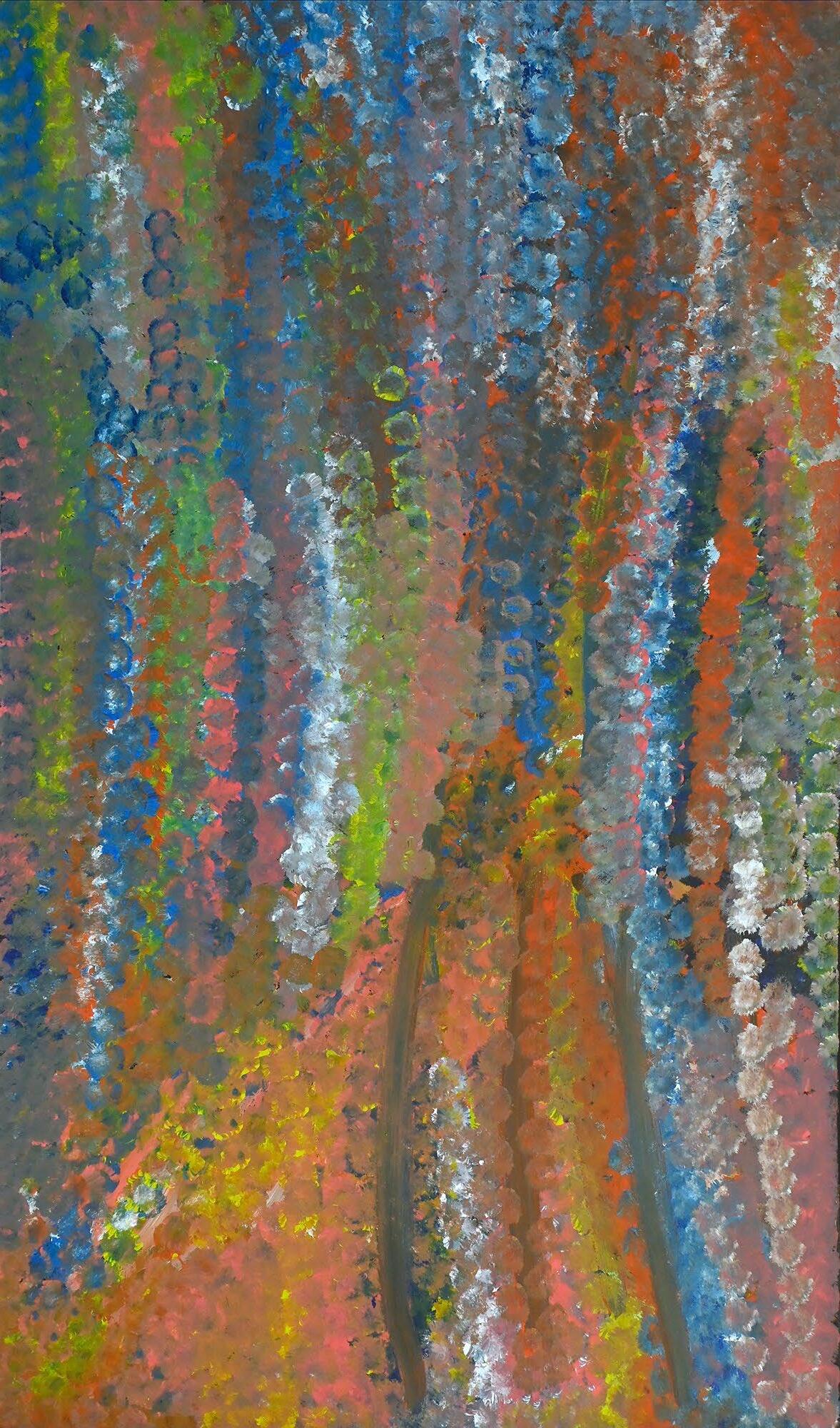
ANGELINA PWERLE (NGAL)
(c. 1939 - )
BUSH PLUM,2022
147.5 x 118 cm; 149.5 x 120 cm (framed)
acrylic on linen
$60,000
PROVENANCE
Painted at Rocket Range, Utopia in 2022
Artlore (Marc Gooch), NT Cat No. 1-822 verso Niagara Galleries, Narrm (Melbourne), Vic Private collection, Gadigal (Sydney), NSW
Tim Klingender Fine Art, Gadigal (Sydney), NSW
Private collection, Gadigal (Sydney), NSW
EXHIBITED
Angelina Pwerle: New Paintings, Niagara Galleries, Narrm (Melbourne), March 2023
Anmatyerre artist Angelina Pwerle began painting her celebrated pointillist interpretations of the anwekety (bush plum) Dreaming in mid-1996, in the weeks following Emily Kame Kngwarreye’s death. From the outset, the Bush Plum works were potent, fully formed and emotionally resonant. Many of these early works were laid on a deep and expansive black ground.
In the years that followed, Pwerle worked with an array of colours, many of them bright and vibrant. However the darker works remained a consistent highlight of her oeuvre and from 2010, they once again began to dominate. One of the two Bush Plum works held by The Metropolitan Museum of Art (painted in 2015) is an example of this pared-back spare palette.
Bush Plum (2022) was painted by Pwerle on-country at Utopia, where she has lived her entire life. It exudes a palpable energy that belies the meticulous nature of its composition. Pwerle is now about 80 years old and completes only a handful of these intricate canvases each year ‚ yet these recent works are as powerful as any she has produced since she began painting on linen in 1988.
Describing the artist’s recent paintings, curator Anne Marie Brody writes: ”Pwerle’s works are, like the late masterpieces of Mark Rothko or Claude Monet, deep crystallisations at the far frontier of creative endeavour.”
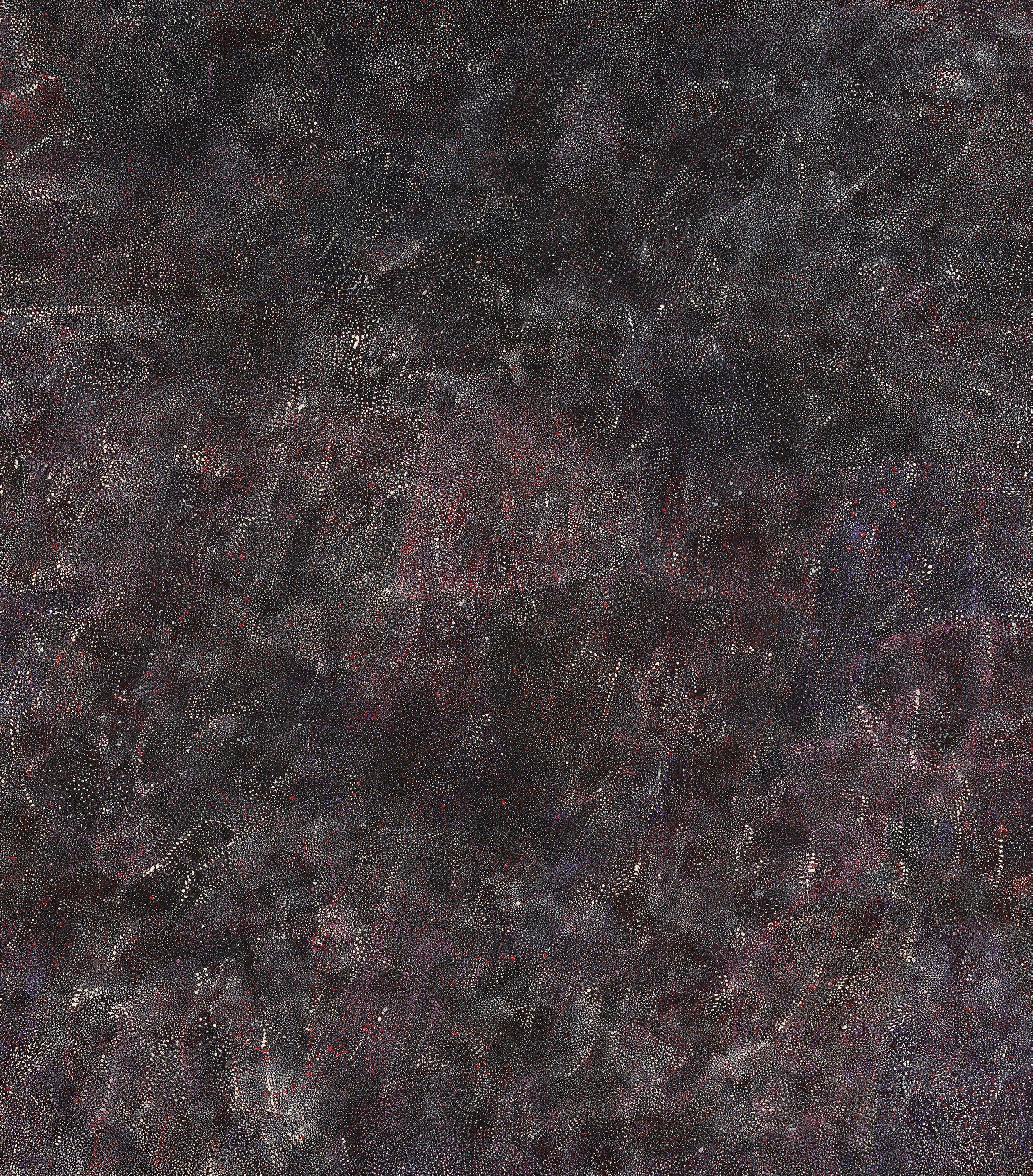
ANGELINA PWERLE (NGAL)
(c. 1939 - )
BUSH PLUM,2011
90 x 90 cm
acrylic on linen
$14,500
PROVENANCE
Painted at Delmore Downs Station in January 2011
Delmore Gallery, Delmore Downs, NT Cat No. 11A010
Picture Window, Gadigal (Sydney), NSW
Private collection, Los Angeles, USA
Private collection, Gadigal (Sydney), NSW
As with her sisters, Kathleen and Poly Ngal, Angelina began producing batiks and wooden sculptures in the mid 1980s, probably influenced by her late husband, the older brother of Cowboy Loy Pwerl. She was formerly known as Angelina ‘Pwerl’, her husband’s name. Pwerl(e) in Alyawarr language is the equivalent to Ngal in the Anmatyerr language, and it is as Angelina Ngal that she is referred to today. She began painting as part of the CAAMA ‘summer project’ in 1988-9 and, already at 40 years of age, was included in the first exhibition of Utopia women’s paintings held in Alice Springs in 1980.
Angelina quickly adapted to painting on canvas and subsequently gained international recognition. Her work can be seen as a contemporary dialogue or translation of the cultural, geographic, social and religious components of Anmatjerre life. Her intimate renditions of country are delicately layered and
can be read and appreciated at a superficial level for their abstraction and painterliness. At a deeper level, however, they depict the cultural and social mores of the society in which she lives.
Angelina paints her grandfather’s country, Alparra. Many of her paintings depict the Bush Plum, which she represents through a focus of many coloured dots flooding the canvas. She also paints the multicoloured wild flowers of her country, producing patchworks of colour in an ethereal landscape.
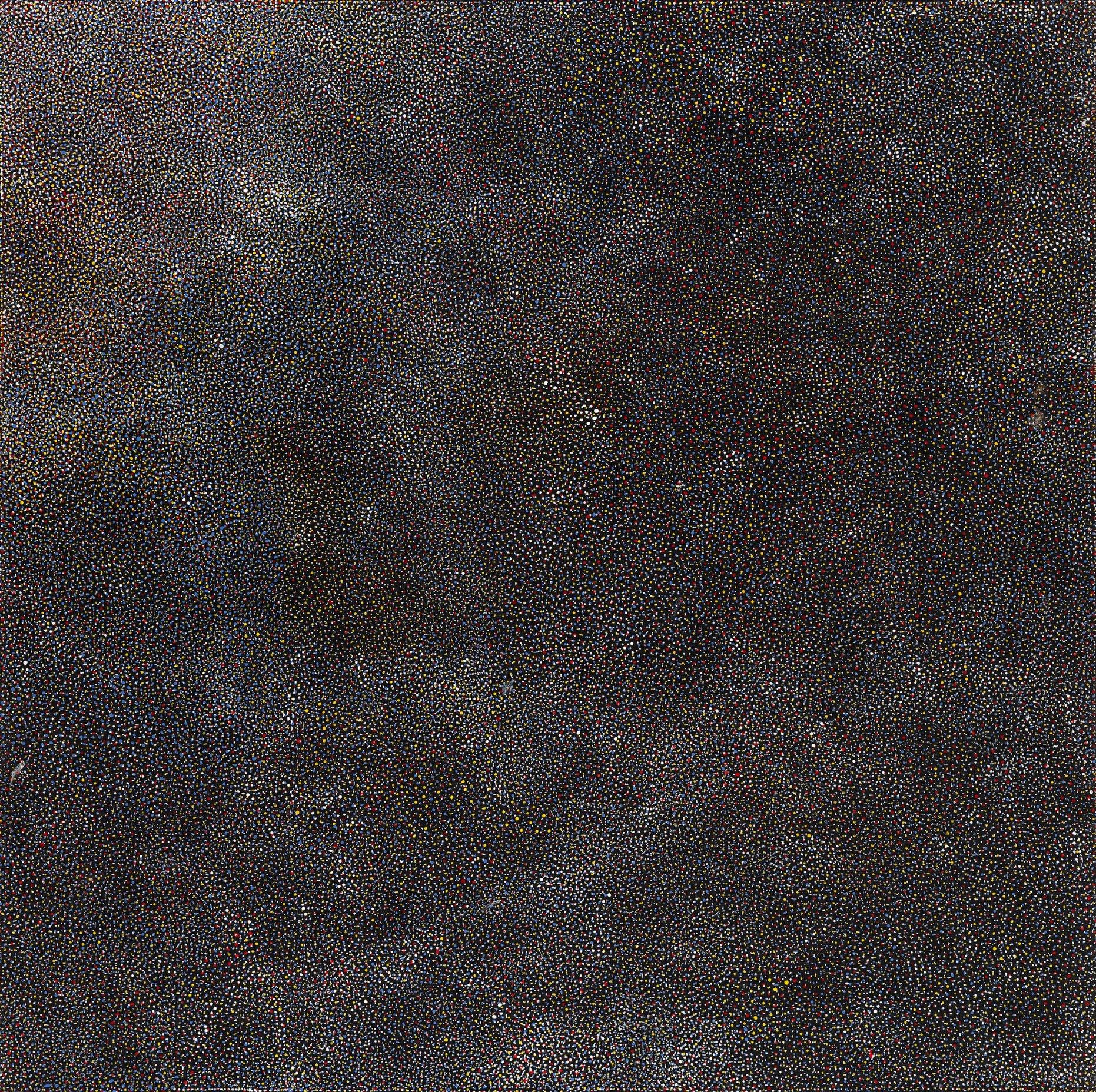
ANGELINA PWERLE (NGAL)
(c. 1939 - )
UNTITLED(BUSHRAISINMAN),c.1995
80 x 14 x 13 cm
acrylic on carved softwood
$3,000
PROVENANCE
Gallery Australis, Tarntanya (Adelaide), SA Lawson~Menzies, Sydney, 25 May 2004, lot 230, as ‘Artist Unknown’ The Gillespie Collection, Gadigal (Sydney), NSW Bonhams, Notable Collections: Australian and Aboriginal Art, 27 August 2025, Sydney, Lot 6 Private collection, Gadigal (Sydney), NSW
This carved figure, most likely titled Bush Raisin Man, comes from Angelina Ngale Pwerle’s deep engagement with the stories of her Country at Utopia, north-east of Alice Springs. Born in 1952, Pwerle has long worked across painting and sculpture, drawing on her intimate knowledge of Anmatyerr traditions. The Bush Raisin, like the Bush Plum, is a food source of both physical and spiritual importance, celebrated in ceremony and represented in art as a way of keeping its story alive.
The figure embodies the presence of a spirit man associated with the Bush Raisin Dreaming. His form, though modest in scale, carries a powerful sense of character and vitality. With simple, direct carving, Pwerle gives shape to an ancestral being whose story would traditionally be passed down through song, dance, and body painting, ensuring that younger generations understand their obligations to land and community.
In making such works, Pwerle moves between the transience of performance and the permanence of sculpture. The figure holds memory in its surface, acting as both a guardian of Country and a reminder of the resources that sustain life in the desert. At once playful and reverent, Bush Raisin Man extends the artist’s practice beyond canvas, keeping ancestral narratives grounded in both form and spirit.
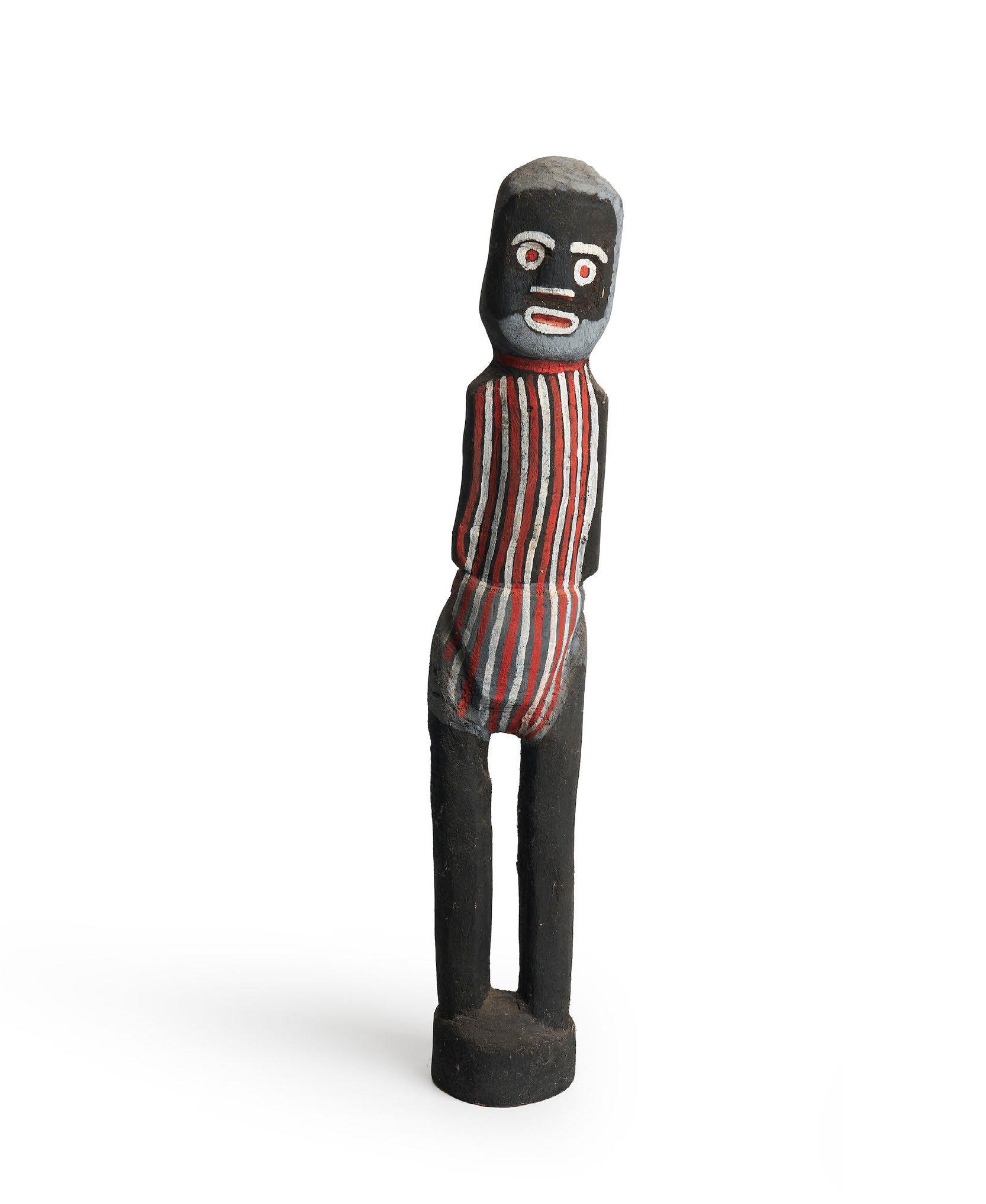
LIN ONUS
(1948 - 1996)
FROGSIN RIVERGRASS,1996
27 x 63.5 cm; 45 x 82 (framed) gouache on illustration board
$45,000
PROVENANCE
Direct from the artist to Belinda Dennis nee Baker, Lin Onus‚ personal assistant (1991-1996)
The Belinda and Craig Dennis Collection, Vic Private collection, Gadigal (Sydney), NSW
Accompanied by certificate of authenticity from Fireworks Gallery and a letter from the original owner
signed lower left ‘Lin Onus’
Lin Onus was born in 1948 in Melbourne, his father being of the Yorta Yorta people from the Barmah Forest country. Onus used images from this area when he took up painting and sculpture in 1974.
He created paintings which were not only essentially Australian but showed what it is like to be an Aboriginal Australian living in a city. He helped to raise the profile of indigenous art, including being one of the leaders of the urban Aboriginal Art Movement.
Importantly, his work is appreciated for his technical skill as much as the mix of styles. His strong socio-political views combined with great expertise resulted in art that is political, provocative and distinct.
Lin Onus’ early works displayed anger at Aboriginal social injustice, but he later employed whimsy to paint a less strident picture. Perhaps he learned the power
of humour from his father, Bill. The story goes that in the early 50s Bill Onus was asked, in his role as President of the Australian Aborigines League, to provide a suitable token Aboriginal name for a new Melbourne community festival. Onus loved to recall how Bill suggested ‘Moomba’ to the gullible city fathers, saying it meant ‘let’s get together and have fun’. With his uncle, Lin Onus... ‘would sit on the banks of the Murray River within view of the Bermah Forest, Onus’s spiritual home, the subject of many of his later paintings and his final resting place.’Ref: Margo Neale, Urban Dingo, The Art and Life of Lin Onus 1948-1996.
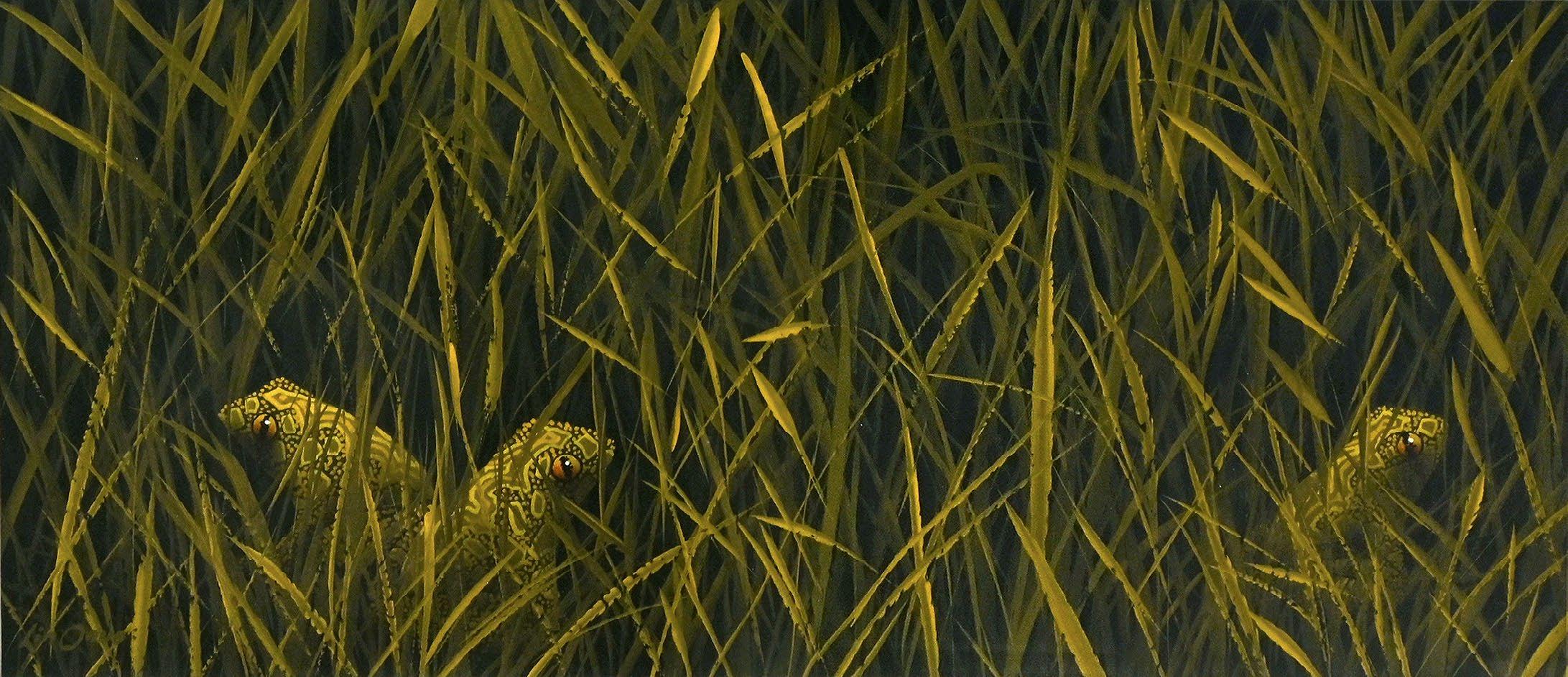
OWEN YALANDJA
(1961 - )
YAWKYAWK,2004
84 x 10 x 10 cm; 30 x 30 x 30 cm (base)
bronze cast
$19,000
PROVENANCE
Maningrida Arts & Culture, NT
Private collection, Germany
thence by descent
Private collection, NSW
Owen Yalandja’s bronze Yawk Yawk embodies the graceful, fluid spirit of the female water beings that inhabit the rock pools and billabongs of his ancestral Country in Western Arnhem Land. Known as Yawk Yawk or Ngalkunburriyaymi, these beings are part mermaid, part woman—ancestral spirits tied to sacred freshwater sites, and deeply significant in the cosmology of Kuninjku-speaking peoples.
Traditionally depicted in bark painting and carved wood, Yalandja’s translation of this spiritual figure into bronze marks a powerful convergence of cultural continuity and contemporary innovation. The sleek form of the figure—elongated, sinuous, and elegant—mirrors the movement of water itself. Her long hair, flowing like tendrils of green algae, connects her to the living ecosystems of springs, creeks and monsoon-fed pools.
Yawk Yawk spirits are guardians of powerful djang (Dreaming) sites. They are associated with conception and transformation—moving between land and water, physical and spiritual realms. It is said they sometimes leave their watery homes to walk across Country at night, luminous and shimmering, glimpsed only by those who know where to look.
In this sculpture, Yalandja honours the knowledge passed down from his father, Crusoe Kurddal, and generations before him. But he also pushes the form into new terrain, forging a path where ancient stories can be told through contemporary material.

DANIE MELLOR
(1971 - )
PERPETUAL(NGARAY),2022
122 x 160 cm
Photographic print on stainless steel
$30,000
PROVENANCE
N.Smith Gallery, Gadigal (Sydney)
label attached verso
Private collection, Gadigal (Sydney)
EXHIBITIONS
PHOTO2022, Tolarno Galleries, Melbourne, 29 April – 21 May 2022 (another example)
Danie Mellor: Recent Works, N.Smith Gallery, Sydney, 29 March – 29 April 2023 (another example)
Serpent: Aboriginal Art from Australia, Musée Yves Saint Laurent, Marrakech, Morocco, 21 July 2023 – 28 January 2024 (another example)
LITERATURE
Stephens, A., ‘More than meets the eye: Danie Mellor captures the things we cannot see’, The Sydney Morning Herald, Sydney, 28 April 2022, https://www.smh.com.au/culture/art-and-design/more-than-meets-theeye-da... (accessed February 2025)
Cox, M., (et al.), Serpent: Aboriginal Art from Australia, Musée Yves Saint Laurent, Marrakech, 2023
In Perpetual (Ngaray), Danie Mellor harnesses the luminous surface of stainless steel to create a striking photographic work that meditates on memory, time, and the enduring presence of Country. The image—highly detailed and rendered in Mellor’s signature cool-toned palette—reflects both the natural world and the viewer themselves, drawing them into a layered dialogue between past and present, self and landscape. The title Ngaray, drawn from the artist’s Mamu and Ngadjon heritage, speaks to a state of continuity and spirit that transcends linear time.
The use of stainless steel as a substrate is deliberate: it evokes permanence, modernity, and reflection—both literal and conceptual. Mellor’s landscape is not simply a scene but a portal into ancestral knowledge systems, where stories are held in land and water, and where presence is felt rather than seen. By merging contemporary materials with deeply cultural content, Perpet-
ual (Ngaray) challenges the viewer to consider how Country endures—alive, remembered, and speaking— through colonial interruption, and into perpetuity.
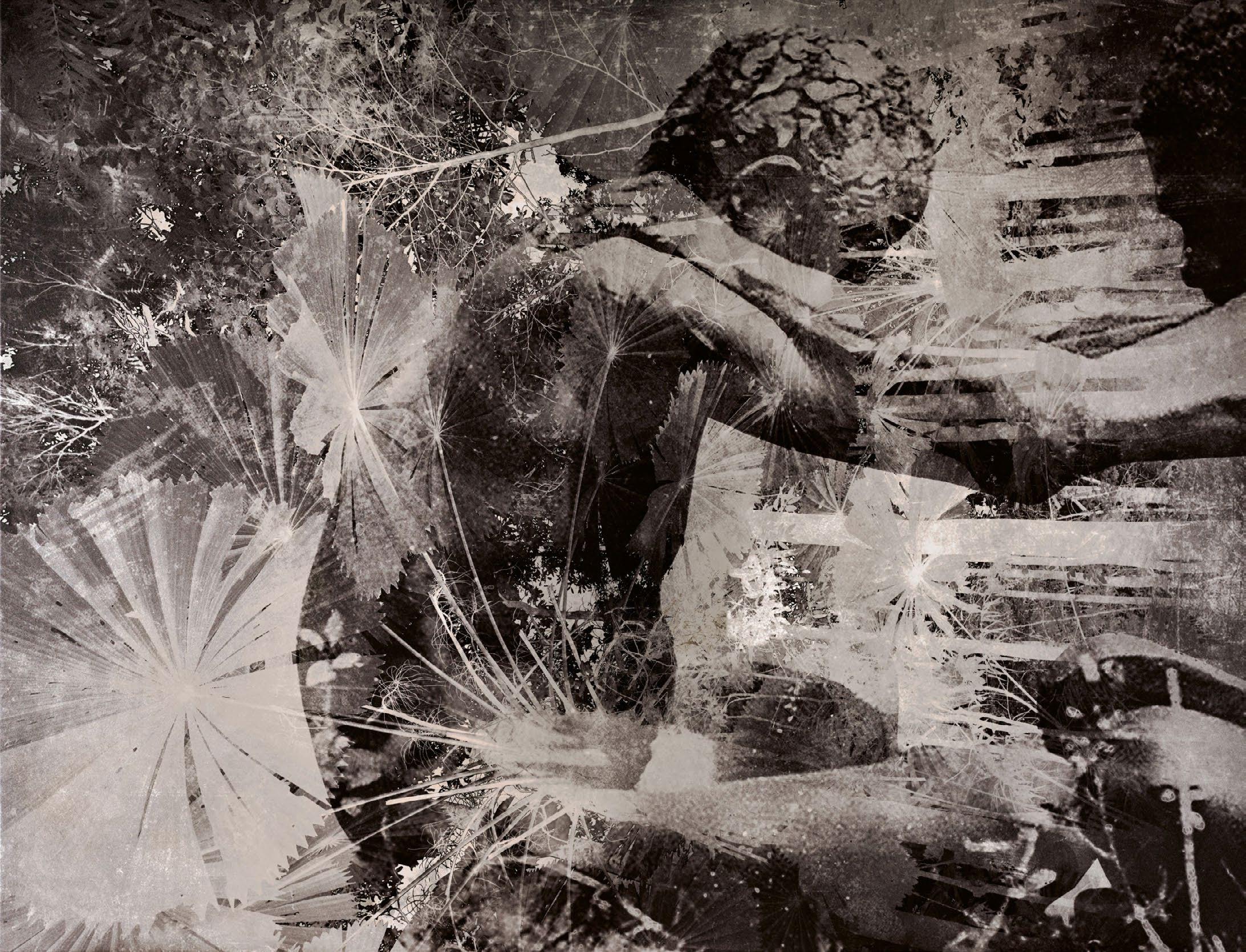
DANIE MELLOR
(1971 - )
TRUNKSHIELD,2003
102 x 45 cm steel and varnish
$5,000
PROVENANCE
Fireworks Gallery, Meanjin (Brisbane), Qld Cat No. 7354 Lawson~Menzies, Sydney, NSW, May 2007, Lot No. 98 Menzies Estate Collection, Narrm (Melbourne), Vic Private collection, Gadigal (Sydney), NSW
Accompanied by the certificate of authenticity from Fireworks gallery
EXHIBITED
What have you done lately...? Fireworks Gallery, Meanjin (Brisbane), Qld, 2004 Entry Points, Fireworks gallery, Meanjin (Brisbane), Qld, 2004
Born in Mackay, Queensland, Danie Mellor is a versatile artist whose creative repertoire encompasses sculpture, photography, printmaking, and drawing.
In this Trunk Shield, Mellor utilises reclaimed metal sourced from the base of a vintage travelling trunk as a potent metaphor to convey the displacement experienced by his great-grandmother, a member of the Mamu/Ngadjonji people. The gradual deterioration of the shield’s metal surface serves as a poignant allusion to the erosion of traditional Indigenous culture over time, a consequence of the influence and intervention of Christian missionaries.
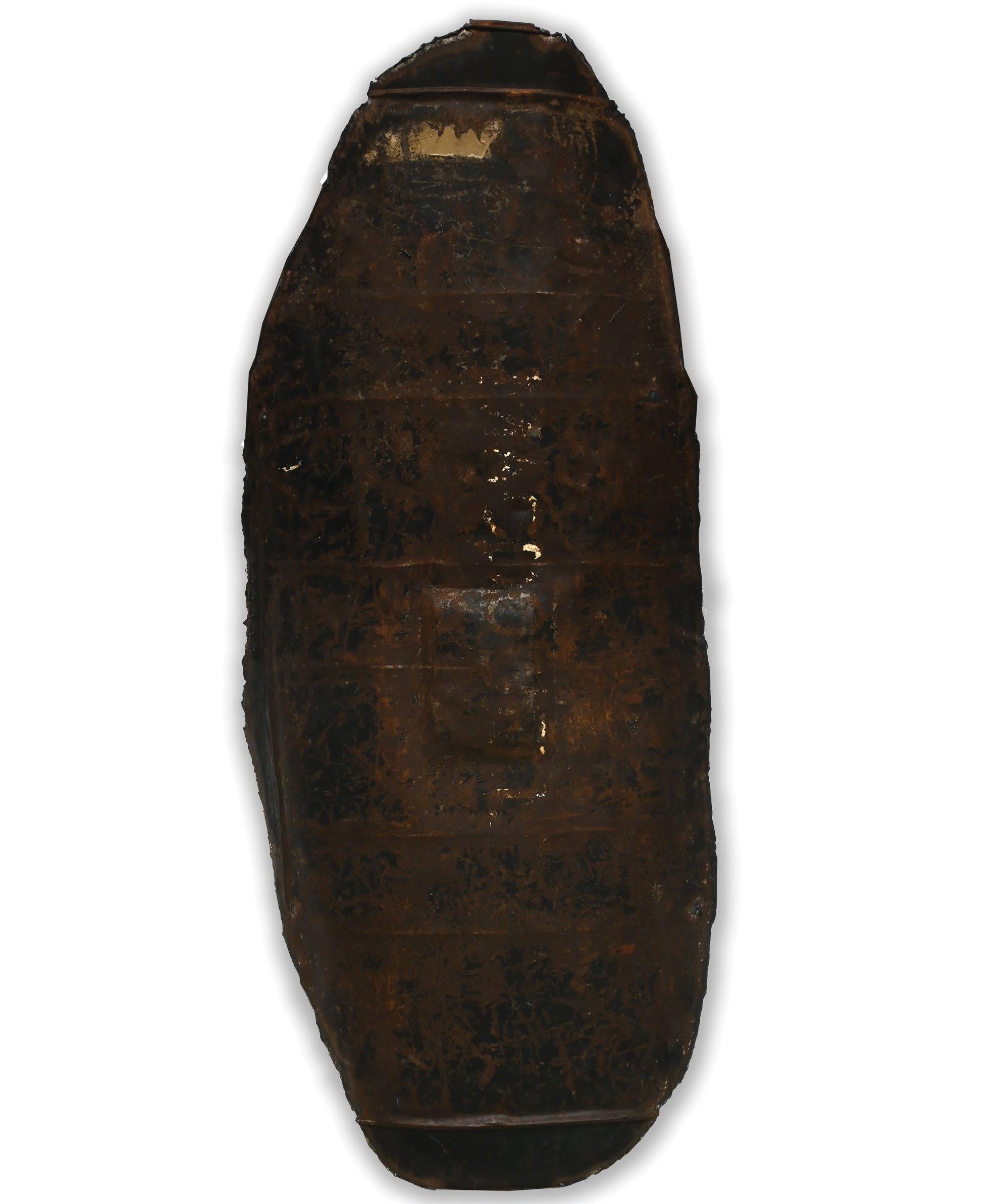
PRINCE OF WALES
(c. 1938 - 2002)
BODYMARKS,1998
102 x 102 cm; 105 x 105 cm (framed)
acrylic on linen
$35,000
PROVENANCE
Karen Brown Gallery, Garramilla (Darwin), NT Cat No. PW313
Private collection, Tarntanya (Adelaide), SA acquired from the above in July 1999
Deutscher and Hackett, Important Australian Indigenous Art, Melbourne, 26/03/2025, Lot No. 7
Private collection, Gadigal (Sydney), NSW
bears inscription verso: artist’s name, title, date, size and Karen Brown Gallery cat. PW313
In Larrakia tradition, senior men who hold custodial authority over land, ceremonies, and dance are often referred to as “Kings.” Around 1935, the artist later known as Prince of Wales was born Midpul at Cullen (Kahlin) Beach, then an untouched stretch of Darwin’s coastline. His father was King George, a prominent Larrakia leader, and his mother passed away when he was still a child. Raised by his mother’s kin, Midpul was taught to become a respected Law Man and Song Man, developing exceptional ceremonial knowledge and skills. He became renowned for leading corroborees, including performances for visiting international dignitaries. In the 1970s, he led the ceremonial dance presented to Queen Elizabeth II on her Commonwealth tour of the Northern Territory, after which he was widely known by the name “Prince of Wales.” Following a stroke that restricted his ability to perform, he turned to painting as a way to preserve the ceremonial body designs that had been central to his life as a dancer and leader. His standing as an artist was affirmed in 2001 when he received the Telstra National Aboriginal and Torres Strait Islander Art Award in the Open Painting category.
The painting Body Marks (1998) exemplifies this commitment to ensuring ceremonial knowledge would endure in painted form. Created on his characteristic white ground, the work depicts a tan rectangular design surrounded by fields of alternating coloured dots. Within the central motif, rhythmic blue-black markings are punctuated with subtle tan and white accents, producing a vibrant sense of movement and intensity. These patterns replicate the body painting that he once applied to men before performance, but here they are transformed into a lasting visual record.
As curator Hetti Perkins has observed, his paintings carry a “musicality,” where dots and bars punctuate the surface with a rhythm akin to sheet music, echoing the songs and dances from which they originate. Painted just a year after his acclaimed 1997 solo exhibition at Gallery Gabrielle Pizzi, Melbourne, Body Marks demonstrates how Prince of Wales transformed ephemeral ceremonial designs into enduring works of art that speak both to Larrakia cultural identity and to a broader history of Indigenous artistic innovation.
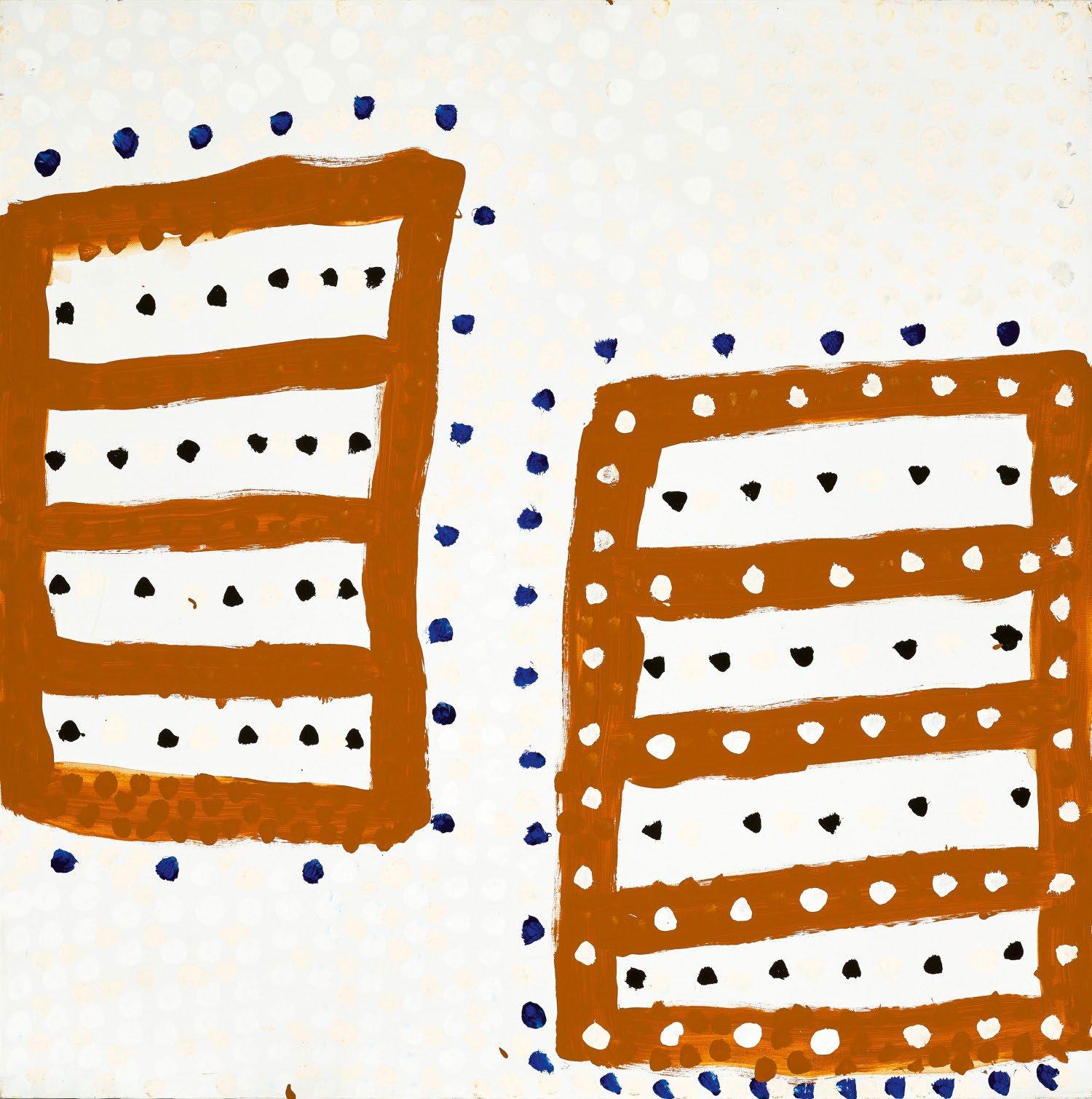
KUTUWULUMI
(2003 - c.1928)
PUMPUNIJILAMARA,2002
93.5 x 74.5 cm
natural earth pigments on Belgian linen
$35,000
PROVENANCE
Jilamara Arts & Crafts, Yermalner (Melville Island), NT, Cat No. 36-02
Aboriginal and Pacific Art, Gadigal (Sydney), NSW
The Collection of Milton and Alma Roxanas, NSW
Bonham’s, The Roxanas Collection Of Aboriginal Art, Lot 167, Sydney, May 2014
Private collection, Gadigal (Sydney), NSW
Accompanied by a certificate of authenticity from Jilmara Arts & Crafts
Kitty Kantilla’s art, and indeed all Tiwi art, is informed by the ornate body painting of the Pukumani ceremony. What makes the art of Kitty Kantilla and those of her generation so inherently important is the fact that the meaning of these designs has been largely lost since the missionary era. She was amongst the very last who inherited them intact.
A seemingly abstract iconography lies at the heart of Kitty Kantilla’s art. Far from being non-representational, the different combinations of dots, lines, and blocks of colour called jilamara (design), when combined, evoke elements of ritual and reveal the essence of Kantilla’s cultural identity. Like other Tiwi artists, Kantilla gained her artistic knowledge in ceremonial contexts, before learning to express her individuality by carving and painting objects related to the Pukumani (mourning) ceremony.
Her artworks, regardless of medium, were always tied to the fundamental Tiwi creation story. Bima, the wife of Purukapali, makes love to her brother-in-law while her son Jinani, left lying under a tree in the sun, dies of exposure. Purukapali becomes enraged and, after his wife is transformed into a night curlew, begins an elaborate mourning ceremony for his son. This was the first Pukumani (mortuary) ceremony, telling how death first came to the Tiwi Islands.

JOHN TJAKAMARRA KIPARA
(1932 - 2002)
WALINNGI(WOMENCATCHINGASNAKE),1973
57 x 34 cm; 73 x 60 cm (framed)
synthetic polymer powder paint on composition board
$35,000
PROVENANCE
Painted at Papunya, NT in 1973
Papunya Tula Artists, NT Cat No. JJ731226
Aboriginal Arts and Crafts, ACT
Anvil Gallery, Albury, NSW
Private collection, NSW
Sotheby’s Australia, Melbourne, Vic, April 1991, Lot No. 60
Private collection, NSW
Adhered verso: the Aboriginal Arts and Crafts Pty. Ltd. certificate and accompanied by original Sotheby’s receipt
EXHIBITED
Aboriginal Art from Papunya, The Anvil Gallery, Albury, NSW, 1974
John Kipara Tjakamarra was a significant Pintupi artist born near Kulkuta, west of Tjukurla, and north of the present-day Kiwirrkurra community. Raised in the salt lake country southwest of Lake Macdonald, he lived a traditional lifestyle into adulthood. His family was among the first to be resettled in Papunya in the early 1960s, and he encountered Europeans for the first time in his 30s.
After arriving in Papunya, he worked with early artists such as Anatjari Tjakamarra, Yala Yala Gibbs, and Freddy West. He became one of the founding members of the Papunya Tula Artists group formed under the guidance of Geoff Bardon in 1971. Bardon described him as a “quiet and gentle man,” whose early paintings echoed traditional sand mosaics used in ceremonial preparations.
Painted in 1973 this painting uses black traveling lines to depict a snake merging into its own tail and concentric circles representing the sacred sites women visited along the the journey to catch the snake. These visual symbols connect the land, the people, and their Dreaming stories. The work was exhibited in what was considered to be the first exhibition of Indigenous fine art in regional NSW when it was exhibited in Aboriginal Art from Papunya at The Anvil Gallery in Albury, NSW, in 1974.
In 1972, John Kipara participated in a film on traditional hunter-gatherers and continued traditional practices such as spear-making and hunting. He lived and worked at Yayayi outstation, where art advisors like Peter Fannin supported the artists. Sales of their art significantly improved local resources, and the artists began to receive government painting allowances.
John collaborated with fellow artists on group canvases, reflecting the communal nature of cultural knowledge. A notable example was a large Tingari canvas exhibited at Australian Perspecta 1981, a milestone that brought Western Desert painting to national and international attention and helped redefine Australian contemporary art.
He returned to his homelands in 1974 and was part of the major 1981 movement to re-establish the Kintore community. John lived the remainder of his life at Walungurru, where he continued to hunt and uphold traditional knowledge into the 1990s. By the end of the decade, he had largely stopped painting. He passed away in 2002, aged 72, leaving a legacy as one of the key figures in the Papunya Tula movement and a custodian of Pintupi culture.

OLD TJAMPITJINPA WALTER
(1912 - 1981)
UNTITLED(WATERDREAMING),1972
61 x 40.5 cm (irregular); 72 x 51 cm (framed) synthetic polymer powder paint on composition board
$65,000
PROVENANCE
Bears inscription verso: ‘19218’
Painted at Papunya, NT in 1972
Stuart Art Centre, NT Cat No. 19218 (Consignment 19, painting 218)
Private collection, SA
Sotheby’s, Important Aboriginal Art, Melbourne, Vic, June 1999, Lot No. 192
Private collection, WA
Thence by descent
The Jory Family Collection, Qld
Much has been written about the genesis of the painting movement in Papunya during the early 1970s. It may in fact be the most documented and studied area of ‘Australian’ First Nations fine art, thanks in part to the expansive documentation and first-hand accounts of Geoffrey Bardon, the school teacher who helped create Papunya Tula Artists with the original group of approximately 20 ‘painting men.’ The group included amongst others Old Walter Tjampitjinpa.
Old Walter Tjampitjinpa, was one of the founding artists of the Western Desert Art movement and was described by Geoffrey Bardon as the custodian of the Water Dreaming. Old Walter worked within a visual language defined by clustered forms and recurring archetypes: the waterhole, running water, and the cave— often sung or depicted as the Water Man. These foundational symbols form a rhythmic pattern within their compositions, reinforcing the sacred narratives.
This painting painted in 1972 is a superb example of Old Walter’s distinctive style of concentric circles representing water sources, flowing lines illustrate the paths of water, and four symmetrically positioned ovals signify ceremonial objects of the Water Men, inscribed with representations of water running between waterholes. Painted in rich, dense, high-contrast dot work in vivid colours. The work reveals a quiet but powerful concentration, rooted in ceremonial knowledge and connection to Country.
Old Walter Tjampitjinpa, who was one of Geoffrey Bardon’s closest friends and confidants among the painting men, played a pivotal role in shaping Bardon’s understanding of the emerging visual language, and his paintings remain central to the history of the movement. For Bardon, it was Old Walter’s kindliness that left a lasting impression:
‘It was for Old Walter... that I felt a strong affection. He spoke in a garbled and very brief and humble manner, repeating in his paintings the simple, classic Water Man and running water images, quietly, yet with a marvellous concentration. His painting was an expression of his eternal and universal response to phenomena such as the desert storms at Kalipimpinpa.’ Bardon goes on to write
‘Old Walter was something of a gentle and kind patron in my gradually improving understanding of the Aboriginal way of life... Later he told me that he was the custodian of the Water Dreaming and his many variations on this theme afforded me knowledge of ceremonial sites and special places.’*
Old Walter Tjampitjinpa’s legacy endures not only in his masterful early boards but also in the way his work continues to reveal the sacred rhythms of Country, story and ceremony.
*Bardon, Geoff, and James Bardon. Papunya : A Place Made after the Story : The Beginnings of the Western Desert Painting Movement. (Miegunyah Press, 2004), pp.73-74
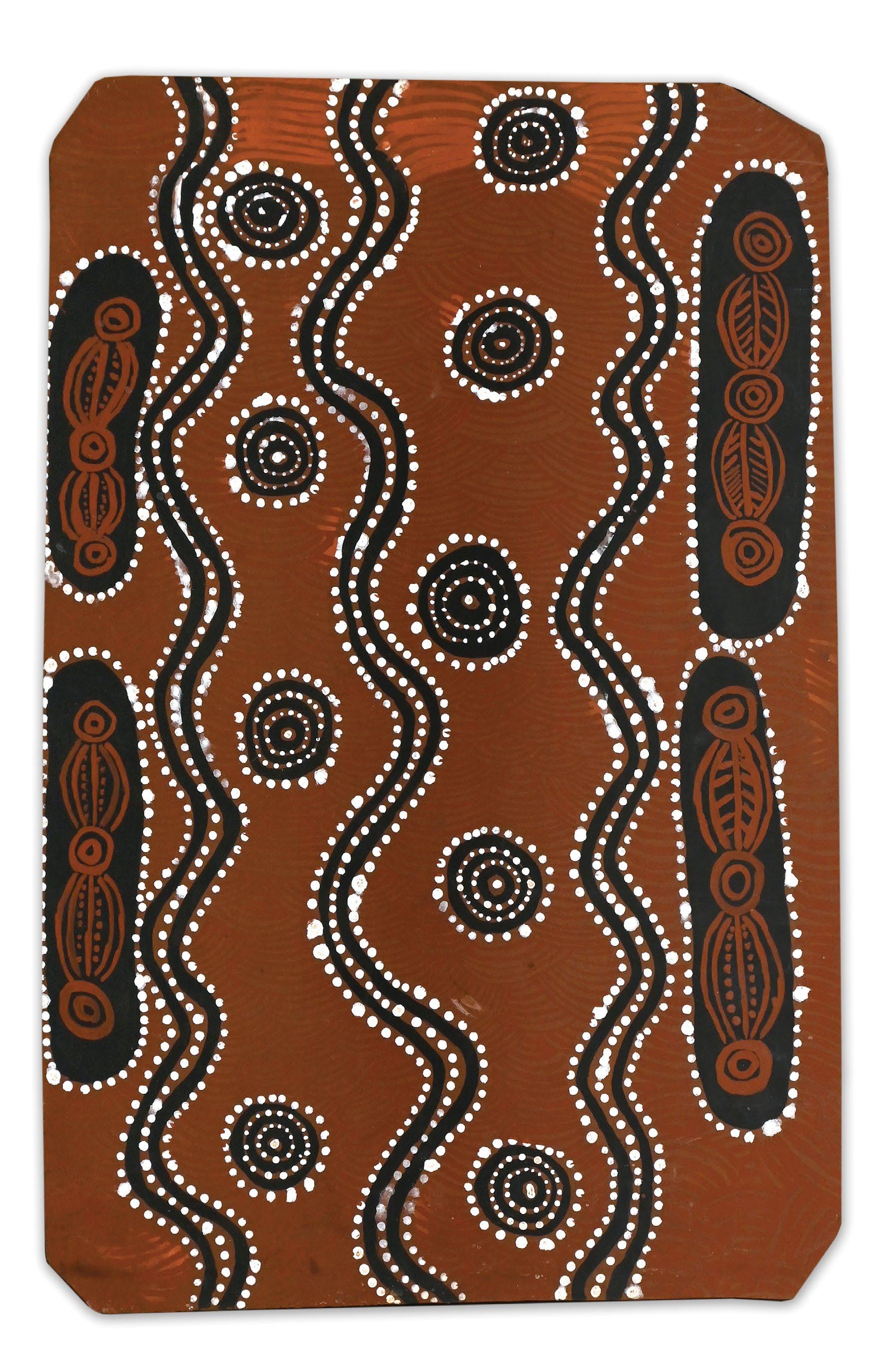
ROVER THOMAS JULAMA
(1926 - 1998)
MOUNTNEWMAN,1995
edition10/50State1
64 x 49 cm (image); 78 x 69 (paper); 82 x 72 (framed) limited edition screenprint on paper
$10,000
PROVENANCE
Created during a workshop in the Warrmarn (Warmun), WA conducted on the 12-26 April 1995
Printed by Basil Hall for Studio One in Kamberri (Canberra), ACT Australian Art Print Network, Gadigal (Sydney), NSW Gallery Gondwana, Mparntwe (Alice Springs), NT Private collection, Gadigal (Sydney), NSW
Accompanied by a certificate of authenticity Gallery Gondwana
This limited edition black and white print depicts the country around Bow River Station in the East Kimberley, where Rover Thomas worked for many years as a stockman. The stockyards and surrounding escarpments were part of Thomas’ everyday world, connecting the realities of station life with his enduring relationship to Country.
The monochrome palette reduces the image to bold forms and tonal contrasts, distilling Thomas’ distinctive visual language. Without colour, the structural qualities of the composition come to the fore, emphasising the rhythms of the land and the geometry of the stockyards.
The work reflects an important theme in Thomas’ practice: the meeting of Aboriginal cultural knowledge with the history of the cattle stations. Through this pared-back vision, Thomas conveys the lasting presence of Bow River as both a site of work and a place of deep cultural significance.

ROVER THOMAS JULAMA
(1926 - 1998)
REDROCKSTOCKYARDS-BOWRIVERSTATION,1995 edition7/50State1
49 x 64 cm (image); 69 x 79 cm (paper); 71.5 x 81 cm (framed) limited edition screenprint on paper
$10,000
PROVENANCE
Created during a workshop in the Warrmarn (Warmun), WA conducted on the 12-26 April 1995
Printed by Basil Hall for Studio One in Kamberri (Canberra), ACT Australian Art Print Network, Gadigal (Sydney), NSW Gallery Gondwana, Mparntwe (Alice Springs), NT Private collection, Gadigal (Sydney), NSW
Accompanied by a certificate of authenticity Gallery Gondwana
This limited edition black and white print depicts the country around Bow River Station in the East Kimberley, where Rover Thomas worked for many years as a stockman. The stockyards and surrounding escarpments were part of Thomas’ everyday world, connecting the realities of station life with his enduring relationship to Country.
The monochrome palette reduces the image to bold forms and tonal contrasts, distilling Thomas’ distinctive visual language. Without colour, the structural qualities of the composition come to the fore, emphasising the rhythms of the land and the geometry of the stockyards.
The work reflects an important theme in Thomas’ practice: the meeting of Aboriginal cultural knowledge with the history of the cattle stations. Through this pared-back vision, Thomas conveys the lasting presence of Bow River as both a site of work and a place of deep cultural significance.
